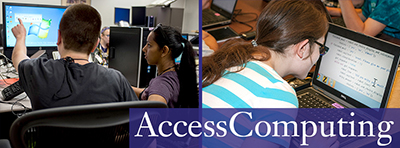AccessComputing News - February 2018

Disability-Related Sessions at SIGCSE
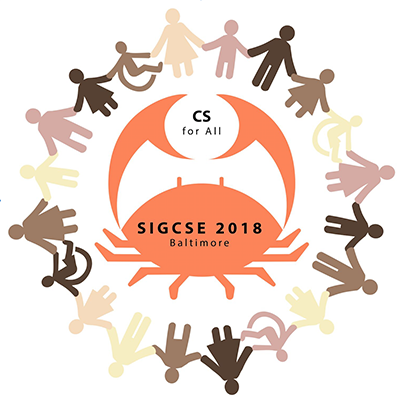
AccessComputing staff is excited about the large number of disability-related sessions at the SIGCSE Technical Symposium (Special Interest Group on Computer Science Education), being held in Baltimore on February 21 − 24. Check out some of our sessions and invite your colleagues! Sessions with an asterisk are organized by AccessComputing.
- Teaching Accessibility in CS Courses, Thursday, 10:45 am, in 322 (Inclusion Track)
- Who Teaches Accessibility? A Survey of U.S. Computing Faculty, Thursday, 2:10 pm, in 319 (Paper)
- Enhanced Robotics! Improving Building and Programming Learning Experiences for Students with Visual Impairments, Thursday, 4:10 pm, in 320 (Paper)
- Access to Computing Education for Students with Disabilities, Thursday, 5:30 pm, in 314 (Birds of a Feather)
- Designing CS Courses using Universal Design Concepts, Thursday, 6:30 pm, in 310 (Birds of a Feather)
- Teach Access: Teaching the Design and Development of Inclusive Technologies for All, Thursday, 6:30 pm, in 314 (Birds of a Feather)
- We’re All in This Together: CS students, the tech industry, and mental health, Thursday, 6:30 pm, in 317 (Birds of a Feather)
- 2018 Panel of Computing Students with Disabilities, Friday, 10:45 am, in 308 (Panel)
- Bridging the Research to Practice Gap with Project TACTICal Briefs, Friday, 3:00 pm, in Exhibit Hall (Poster)
- Teaching Inclusive Thinking to Undergraduate Students in Computing Programs, Friday, 4:35 pm, in 316 (Paper)
- A Cross-Case Analysis of Instructional Strategies to Support Participation of K-8 Students with Disabilities in CS for All, Saturday, 9:10 am, in 320
- Inclusive Teaching, Saturday, 8:45 am, in 322 (Inclusion Track)
More information on these sessions, as well as others at SIGCSE, may be found in the event program.
New Astronomy-Themed Accessible Hour of Code

One of the AccessCSforAll Principal Investigators (PI) Andreas Stefik released a second accessible Hour of Code Activity this fall, just in time for Computer Science Education Week. The new Hour of Code explores astronomy and uses the Quorum programming language. Quorum is an evidence-based programming language that is design to be accessible.
Based on the traffic, the new Hour of Code is a great success with over 57,000 page views during Computer Science Education Week alone. The Quorum Hours of Code are the only accessible tutorials included in the Hour of Code activities, thereby opening up this opportunity to students with disabilities who may not otherwise be able to participate.
Learn more about Quorum and other AccessCSforAll initiatives here.
AccessComputing Partners with DREU
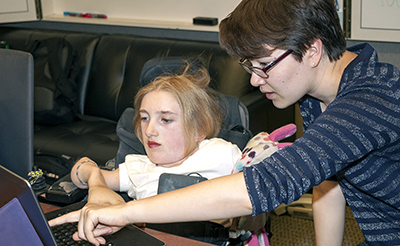
The Computing Research Association's Distributed Research Experience for Undergraduates (DREU) is a program that supports summer research experiences for undergraduate students from groups that are underrepresented in the computing field. Those groups include women, Hispanic Americans, African Americans, and people with disabilities.
In the past AccessComputing has run its own 10-week summer research program for undergraduates, while also recommending students to join the DREU program. Because of the wonderful infrastructure that the DREU program is giving its students and faculty mentors, AccessComputing is now partnering directly with DREU program starting in 2018. Students with disabilities will now first apply to the DREU program and be able to indicate that they are an AccessComputing team member to receive funding. When applying for the DREU program a student can, but doesn't have to, identify a faculty mentor they would like to work with. If the student does not identify a faculty mentor, then the DREU and AccessComputing staff will work to find a suitable mentor for the student. A typical stipend for a 10-week research internship is $7,000 plus travel expenses.
Any computing student with a disability can join the AccessComputing Team to obtain its benefits including peer mentoring, professional development activities, paid tutoring, funding for conference travel, and industry and academic internships. Students who want to join the AccessComputing Team should apply here. Students and mentors can apply for the DREU program here. The deadline is February 15, 2018, though applications are still accepted after that date.
Teach Access Paper at SIGCSE
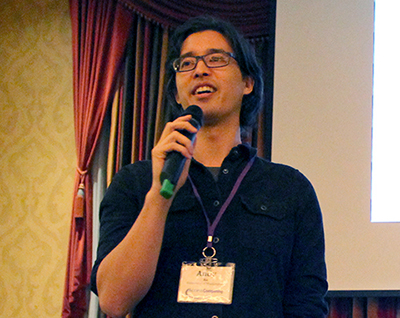
Over the past year, the AccessComputing team has worked on a national survey on teaching accessibility. We reached out to 14,176 computing and information science faculty at all institutions of higher education in the United States, and received 1,857 full responses.
The goal of the survey was to learn who is teaching accessibility, what they are teaching, and what barriers faculty see to teaching about accessibility. We found that, of those who responded, about 20% reported teaching something about accessibility in at least one of their courses. Overall, this represents a minimum of 2.5% of faculty surveyed. While this may seem small, about 50% of the institutions that responded had at least one elective course that taught something about accessibility and 75 institutions had at least two faculty teaching accessibility. There were only 17 self-described faculty accessibility experts, spread across 14 institutions.
Of the faculty who responded, those who teach accessibility were twice as likely to be female, twice as likely to view accessibility as part of computer science (CS) curricula, three times as likely to have expertise in accessibility, and about 1.5 times as likely to know someone who has a disability.
Most importantly, even amongst faculty who do not teach accessibility, most respondents believed that accessibility should be taught in CS. They just did not believe they had enough expertise and did not know how the topic connected to their specific sub-areas of CS.
AccessComputing and Teach Access are using these results to prepare new materials that provide this missing expertise and these missing links to CS curriculum.
AccessComputing Launches Social Media
AccessCSforAll and Participant Highlighted in College Board Newsletter
In their December newsletter, the College Board ran an article about the importance of having access to coding and other aspects of computer science. Last year, with the creation of a new Advanced Placement Computer Science Principles course (AP CSP), the College Board opened doors for underrepresented groups in computing, including students with disabilities.
Last year, Grady Thompson, a 2015 Scholar and AccessComputing team member, took AP CSP. “The AP CSP course in high school solidified my interest in computing fields and motivated me to apply to the informatics program at the University of Washington,” said Grady.
To increase the accessibility of their AP CSP class, the College Board has partnered with AccessCSforAll. Richard Ladner, AccessComputing and AccessCSforAll PI, says they are “working together to create a fully accessible version of AP CSP that uses research-based accessible tools such as the Quorum programming language.”
Read the full article here.
Accessible Information and Communication Technology

The Accessible Information and Communication Technology (AICT) program is a summer research program for deaf, hard of hearing, and hearing undergraduates at Gallaudet University in Washington, DC. The AICT program will run for 10 weeks from May 21 to July 27, 2018 and provides participants with a highly creative, collaborative, inclusive, and mentored summer research experience on accessibility and technology.
Previous program alumni have created novel interfaces for showing captions, interpreters, and automatic speech-to-text. Alumni have also developed guidelines for usability, presentation, and readability of these accommodations. Five alumni (three deaf and two hearing) are in master's programs, and four alumni (three deaf, one hearing) are in PhD programs. Two have Graduate Research Fellowships from NSF. The inclusion and collaboration between deaf and hearing peers in the program has increased the number of researchers and widened the research being done in the AICT field. Including deaf individuals, or anyone from diverse backgrounds, important when developing new ideas because, as William Wulf, former President of the National Academy of Engineering, once said: “creativity does not spring from nothing; it is grounded in our life experiences... Lacking diversity on an engineering team, we limit the set of solutions that will be considered and we may not find the best, the elegant solution.”
The AICT program provides participants with training, experience, and support to create accessible technology to solve concrete problems faced by deaf or low vision users in their regular use of ICT, including television or augmented reality. Participants will get to meet deaf professionals and researchers, and tour institutions involved in accessible ICT policy, such as the Federal Communications Commission, the National Association for the Deaf and the U.S. Congress.
To apply, you must be an undergraduate student in good standing and an U.S. citizen or permanent resident. For more information on the AICT program or on applying, email the AICT Director, Dr. Raja Kushalnagar at raja.kushalnagar@gallaudet.edu, or visit their website to apply.
Gallaudet University is located in Washington, DC. Over the summer, students in the AICT program can visit destinations like the US Capitol, the Library of Congress, the Washington Monument, and the National Mall, where the Smithsonian Institution museums are located. The underground Metrorail system makes travel in the city quick and easy.
ABET Recognizes Accessibility
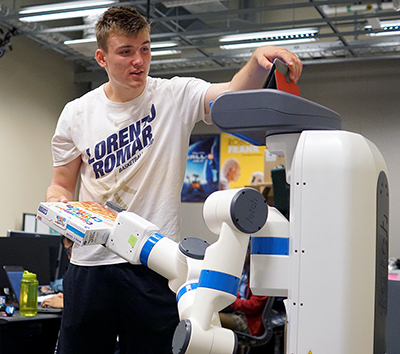
ABET is the accrediting board for college and university programs in the disciplines of applied and natural science, computing, engineering and engineering technology at the associate, bachelor, and master degree levels. For 2017-2018 ABET added "accessibility" as one of the potential constraints in its definition of "Engineering Design." This is in recognition that people with disabilities should be considered as users of products and services that are developed by engineers and computer scientists. It also reflects the desire by companies to hire students who have some experience in accessible design.
The ABET definition of Engineering Design now reads as follows: "Engineering design is the process of devising a system, component, or process to meet desired needs and specifications within constraints. It is an iterative, creative, decision-making process in which the basic sciences, mathematics, and engineering sciences are applied to convert resources into solutions. The process involves identifying opportunities, performing analysis and synthesis, generating multiple solutions, evaluating those solutions against requirements, considering risks, and making trade-offs to identify a high quality solution under the given circumstances. For illustrative purposes only, examples of possible constraints include accessibility, aesthetics, constructability, cost, ergonomics, functionality, interoperability, legal considerations, maintainability, manufacturability, policy, regulations, schedule, sustainability, or usability" (our emphasis).
This is just one of the reasons you may want to teach accessibility. See the AccessComputing website for more.
Engaging Videos about Accessible Computing
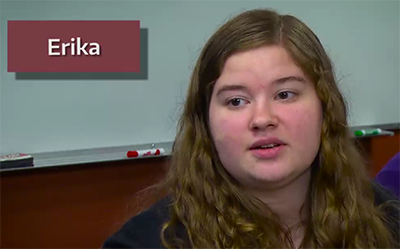
Videos can often help spread the word about how to engage students with disabilities in computing courses, projects, and careers. Check out the following popular short videos on the AccessComputing website:
- How Can We Include Students with Disabilities in Computing Courses?
- How Can We Encourage Students with Disabilities to Pursue Computing?
- Quality Education Is Accessible
- Graduate School and Students with Disabilities
AccessComputing and DO-IT also create videos that share how IT can be made accessible to individuals with disabilities. These videos are found on the comprehensive DO-IT website. Here are a few titles to look for:
- Captions: Improving Access to Postsecondary Education
- IT Accessibility: What Campus Leaders Have to Say
- Using a Screen Reader
iPhone X and Accessibility
Apple has done a good job in recent years of building products that are usable by people who have a variety of characteristics. In iOS, the operating system that drives Apple’s mobile devices, there are dozens of features available under Settings > General > Accessibility, grouped into categories “Vision,” “Interaction,” “Hearing,” “Media,” and “Learning.” Screen reader users in particular are drawn to iOS devices due a numerous accessibility features, as seen in WebAIM’s latest Screen Reader User Survey.
In November 2017, Apple released the iPhone X, the first in Apple’s next generation of smart phones. The accessibility community expressed some initial concerns about the impact of new iPhone X design choices and features on accessibility. Concerns focused primarily on two features: Elimination of the home button and Face ID.
No More Home Button
Prior to iPhone X, the Home button provided a large tactile target that users could press in order to perform various functions. For example, tapping once returned users to the home screen. Tapping twice could be configured to enable “Reachability,” a feature that lowers the top of app windows so users with limited hand dexterity can more easily access common controls located at the top of apps. Tapping three times could be configured to serve as an “Accessibility Shortcut,” used to toggle a single accessibility feature or display a menu of multiple accessibility-related features, depending on how users configured it.
Eliminating the Home button left questions as to how users would perform these important functions. Fortunately, all functions are still supported, just by using different methods. Users can return to the home screen by swiping up from the bottom of the screen; they can enable “Reachability” by swiping down from the bottom of the screen; and they can initiate the “Accessibility Shortcut” by tapping three times on the side button.
Whether these methods are as accessible as using the Home button is a question of some debate. Swiping up or down from the bottom of the screen requires some dexterity, and has different results if the user starts too far from the bottom or holds their finger on the screen too long. Also, tapping three times on the side button requires careful precision, as tapping twice opens Apple Pay, and (more critically) tapping five times initiates “Emergency SOS”, which automatically calls 911. If accidentally triggering the latter is a concern, it can be configured (in Settings > “Emergency SOS”) to wait for three seconds prior to calling 911, during which time the user can cancel the call. It can also be disabled altogether, although having easy access to emergency services is arguably a nice feature.
Face ID
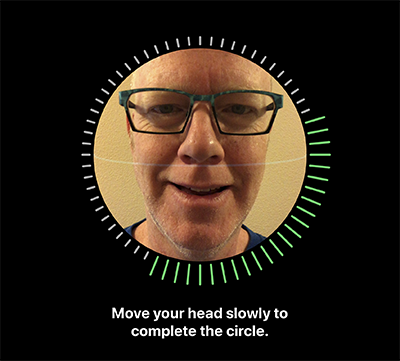
The other feature that has caused some initial concern, particularly within the blind/low vision community, is Face ID. This is one of the highest profile new features of the iPhone X, as it showcases new levels of sophistication in face recognition technology. Face ID uses automatic face recognition for unlocking the phone, downloading apps from the App Store, or conducting financial transactions using Apple Pay. Apple claims their face recognition technology, which uses 3D modeling of the user’s facial features, is more secure than fingerprint recognition. It’s also an accessibility improvement for people who have no fingers or fingerprints.
For people who are blind, the process of setting up Face ID is reasonably accessible using VoiceOver (the screen reader that comes with iOS). VoiceOver coaches users through the setup process with prompts such as “Move iPhone a little higher” and “Tilt your head up and to the right.” However, once Face ID is setup, it requires users to gaze directly into the phone, which is a difficult task for users who are unable to see. Even if VoiceOver provides verbal assistance, this can be a much more burdensome process than touching the device with a finger. Fortunately, Face ID is optional with the iPhone X. Users can control which features require it, or they can disable it altogether, in which case the iPhone falls back to other security methods.
Summary
iPhone X still has the dozens of accessibility features that iPhone users are accustomed to. However, Face ID and the lack of a home button are changes that some users may find problematic. As an alternative, the iPhone 8 and iPhone 8 Plus were released shortly prior to the iPhone X, and offer many of the same improvements (e.g., faster processor, better camera, water resistant, wireless charging) yet still have a home button and Touch ID. To compare all three models (or other older models), visit Apple's website.
About AccessComputing
Led by the Paul G. Allen School of Computer Science & Engineering, the Information School, and DO-IT (Disabilities, Opportunities, Internetworking, and Technology) at UW, AccessComputing is supported by the National Science Foundation (NSF) (Grant #CNS-0540615, CNS-0837508, CNS-1042260, CNS-1539179). Any opinions, findings, and conclusions or recommendations expressed in this material are those of the authors and do not necessarily reflect the views of the NSF. For further information, to be placed on the mailing list, request materials in an alternate format, or to make suggestions for project publications or web pages, contact us:
AccessComputing
University of Washington
Box 354842
Seattle, WA 98195-4842
accesscomp@uw.edu
www.uw.edu/accesscomputing/
206-685-DOIT (3648) (voice/TTY)
888-972-DOIT (3648) (toll free voice/TTY)
206-221-4171 (FAX)
AccessComputing Principal Investigators:
Richard Ladner, PI
Sheryl Burgstahler, Co-PI
Amy J. Ko, Co-PI
Jacob O. Wobbrock, Co-PI
Brianna Blaser, Project Coordinator
Kayla Brown, Project Coordinator
